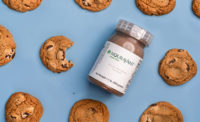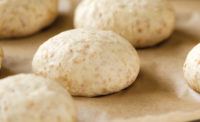Mix it up with dough conditioners and premixes




According to culinary icon James Beard, “Good bread is the most fundamentally satisfying of all foods; and good bread with fresh butter, the greatest of feasts.” The quality of bread is determined by flavor, color, volume, appropriate moisture and texture of both the crust and the crumb. All good bread starts with the essentials: flour, water, salt and leavening. And, of course, bakers can introduce additional ingredients to yield a more-complex flavor.
For the commercial baker, achieving the desired characteristics on a consistent basis—as cost-effectively as possible—can prove challenging. As such, bakers use dough conditioners and/or premixes to overcome some of the technical and financial hurdles involved in bread making while enabling desired product quality.
Strength through conditioning
The group of ingredients that falls under dough conditioners is classified into seven categories: yeast nutrients, emulsifiers, oxidizing agents, reducing agents, pH regulators, vital wheat gluten and enzymes. Bakers can use a combination of these dough conditioners to better control the bread chemistry to yield the desired outcome. Ingredient functionality can strengthen or soften the dough, speed up or slow down the reactions, modify pH, or alter the color.
“A true dough conditioner is a blend of multiple functional ingredients,” says Nicole Rees, business development manager, Glanbia Nutritionals, Carlsbad, CA. “Fundamentally, every application requires a different dough conditioner, particularly when working to maximize cost benefits. ”
The right conditioner might even have to change from year to year depending on recent growing-season variables, which can influence the composition of the wheat crop—and ultimately the flour. Take, for instance, the protein content in wheat flour. It can change from year to year based on the weather and crop conditions. For bagels, the ideal protein content is 12–14 percent, says Bassey Ekpo, president, Global RDIS, Swedesboro, NJ. “If the protein content in the wheat is not in the right range, bagels will not form properly in commercial equipment. The dough has to be strong enough to stretch, but soft enough to tie. If the protein content is too low, you can add strength with vital wheat gluten as a dough conditioner to improve the runnability of the dough.”
Going label-friendly
Recently, select consumer demographics have expressed concerns about particular ingredients, including some traditionally used as dough conditioners, driving ingredient suppliers to develop new options. One ingredient receiving attention is azodicarbonamide (ADA), a dough strengthener. ADA has been approved for use by FDA, but banned in the European Union and Australia, with the latter countries concerned about ADA as a potential carcinogen. In the U.S., consumer groups successfully petitioned fast-food sandwich specialist Subway to reformulate its bread to remove ADA.
“Today’s consumers are more discerning than ever, scrutinizing labels and seeking a simple ingredient list with recognizable components,” says Rees. But they still demand products with excellent appearance, taste and texture. “Reducing the number of ingredients on a label and eliminating complicated or unfamiliar ingredients to produce a simple formulation must not affect the enjoyment of the end product,” she adds.
Replacements can often be found for emulsifiers like sodium stearoyl lactylate, mono- and diglycerides, gums such as guar and xanthan, and modified starches. Rees notes that her company has a unique ingredient made from specially milled flax that helps with moisture management, functionality usually supplied by gums and emulsifiers. The ingredient reportedly helps reduce shrinkage on sheeted and laminated dough and enables easier pressing in tortillas.
Premix solutions
Some manufacturers are turning to premixes to help them improve operations and make their life easier. Premixes add convenience; incidental ingredients can be included in the premix and reduce the number of separate containers that need to be opened and the number of ingredients that need to be weighed out. For some manufacturers, an important benefit of premixes is the ability to have additional validation that all of a formula’s ingredients are in the finished product.
Premixes can also drive cost efficiencies and improve consistency. A decrease in ingredient handling time means shorter production cycles and a potential decrease in measuring errors from having to weigh out multiple, small quantities. By having fewer separate ingredients to order and warehouse, bakers can achieve efficiencies in raw material handling. The flip side of all this efficiency is a reduction of flexibility. Making small modifications to a formula can become a cumbersome and lengthy process.
“Today, premixes represent a larger percentage of the finished product than ever before,” says Russ Hazen, premix innovations manager, Fortitech Premixes, DSM, Schenectady, NY. “We are now seeing requests for more complex and more customized blends. Functionally, the premixes include more ingredients and have increased functionality than in prior years. The key is that you still have to know where and how the premix will be used, and the customer may still need multiple premixes, based on their processing.”
As straightforward as it might sound to create one premix, adding all ingredients in one step presents some processing challenges. However, suppliers rely on technical advances to overcome various processing hurdles. With encapsulation, the active ingredient is encased in a protective outer coating, which could be anything from a carbohydrate matrix to an empty yeast cell. Encapsulation provides protection, stabilization or slow release. An additional benefit is broader range of solubility—fat-containing ingredients can be dissolved in water, and water-soluble ingredients can be added to water-insoluble solutions.
Consumer demand is also driving some interesting innovation in the field of premixes. “With the increased interest in gluten-free products and vegetarian protein sources, we are getting more requests for nontraditional sources of protein, like pea protein, requests for flax and ancient grains, and requests for nontraditional fiber sources to be included in our premixes,“ notes Hazen.
Another growing area of interest is in nutritionally oriented botanicals, herbs and other ingredients, such as DHA, ginseng and gingko—ingredients that can prove attractive to shoppers seeking better-for-you products. The ability to add nutritionally functional benefits to foods via botanicals grows more viable as the list of GRAS ingredients approved for use in food grows longer. Again, encapsulation can help preserve the integrity of these ingredients during processing and baking, and through shelf life.
Hazen notes that his company has seen demand for its DHA omega-3, which is sourced from algae, so it is vegetarian, kosher, halal and allergen-free, along with an oat beta-glucan fiber ingredient.
Consumers read labels more closely. They want nutrition and quality. And they also don’t want to pay more for the products. As such, bakers can use dough conditioners and/or premixes to streamline operations while potentially creating unique points of differentiation in their products through use of forward-trending ingredients included in the premix. And it’s all in the quest of baking “good bread.”
Premix Possibilities
Premixes often include a set percentage of flour along with any number of other functional, flavor, nutritional and other ingredients. Premixes save time in the plant and—along with proper mixing procedures—help ensure precise distribution of ingredients. Some possible ingredients that might go into a premix include:
- Flour/grains
- Bran
- Potato flour/flakes
- Malt flour/extract
- Spices/seasonings/flavors
- Seeds
- Sweeteners
- Gluten
- Dry leavening/sponge
- Enzymes
- Emulsifiers
- Acidulants
- Hydrocolloids/starches
- Vitamins/minerals
- Omegs-3s
- Fiber
- Malt
- Dairy like whey, NFDM, dried egg
- Cocoa
Looking for a reprint of this article?
From high-res PDFs to custom plaques, order your copy today!







